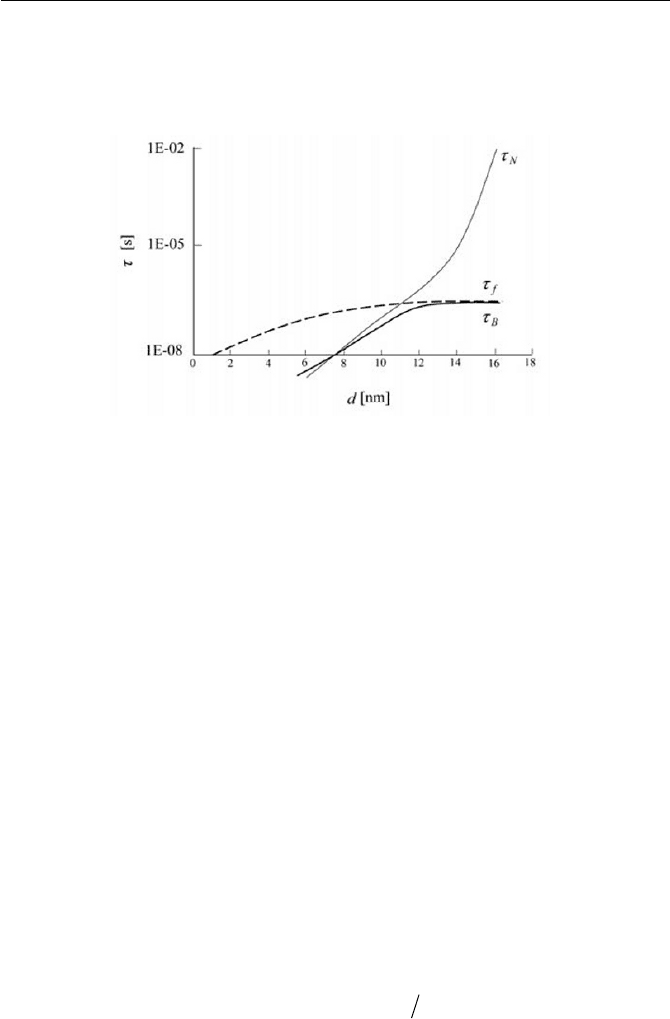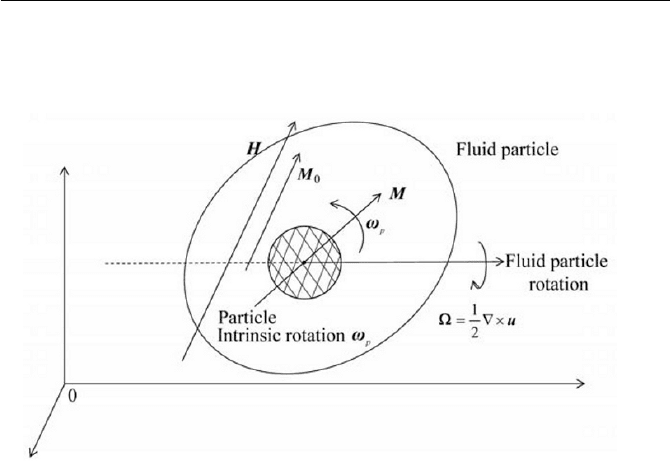Yamaguchi H. Engineering Fluid Mechanics (Fluid Mechanics and Its Applications)
Подождите немного. Документ загружается.


Exercise
altered. Draw curves of
N
W
and
B
W
for the diameter of a colloidal particle
of a magnetic fluid. Also compare the results if the effective relaxation
time
f
W
is given via the following expression, Martsenyuk et al. (1974)
NB
NB
f
WW
WW
W
(1)
Use the following representative values of the properties of a magnetic
fluid, if necessary
Fefor;K
5
10470 u .K
»
¼
º
«
¬
ª
3
m
J
;
0
f
9
0
101u f
»
¼
º
«
¬
ª
s
1
;
B
k
23
10381
u .
B
k
»
¼
º
«
¬
ª
K
J
Kerosenefor
0
;
K
3
0
1020
u .
K
»
¼
º
«
¬
ª
sm
kg
Ans.
Let the temperature be 25 , i.e.
K29827325 T
.
V
~
appearing in
Eq. (8.1.3) includes the thickness of the surfactant layer, which gives
V
~
to
write
3
2
6
sdV
S
~
(2)
where
ms
9
102
u is assumed. Thus, the relaxation time due to the Néel
relaxation
N
W
given in Eq. (8.1.5) and the relaxation time due to the
Brownian relaxation
B
W
given in Eq. (8.1.4) are respectively written as
»
¼
º
«
¬
ª
uuuu
29810381
6
10470exp10
23359
.. d
N
S
W
(3)
2981038110201022
6
3
233
3
9
uuuuuuu
..d
ʌ
IJ
B
(4)
The effective relaxation time
f
W
can be calculated in Eq. (1), knowing
N
W
and
B
W
from Eqs. (3) and (4). The curves of Eqs. (1), (3) and (4) are
C
q
505

displayed in Fig. 8.3. In a real magnetic fluid, due to a broad size distribu-
tion, the exact evaluation of the relaxation time is difficult. A precise deter-
mination of the relaxation times requires direct experimental observation.
Fig. 8.3
R
Relaxation of magnetization
Problems
8.1-1 Plot the equilibrium magnetization curve using the Langevin func-
tion given in Eq. (8.1.1). Use values of the parameters, if necessary,
for the particle size
d =10nm at the temperature
T
=298K with
m
I
=0.041 and
s
M
=0.04Tesla.
8.1-2 In taking into account the parallelism of
M and H , i.e. HM // , the
induction of
B can be expressed by the magnetic permeability
s
P
of a magnetic fluid. Show that
s
P
contains the magnetic susceptibil-
ity
F
and the permeability of free space
0
P
.
Ans.
»
»
»
»
»
»
¼
º
«
«
«
«
«
«
¬
ª
H
H
HǾ
MǾB
MǾB
s
0
0
0
0
P
FP
FP
P
P
8.1-3 Draw a curve for the viscosity ratio
0
K
K
a
of a magnetic fluid as a
function
v
I
under no magnetic field, referring to Eq. (8.1.8). Use a
value of
|
c
I
0.74 for the result.
8 Magnetic Fluid and Flow 506

8.2 Ferrohydrodynamic Equations
8.2 Ferrohydrodynamic Equations
In the theory of magnetic fluid, ferrohydrodynamic equations are derived
from a continuum mechanics on a microscopic treatment used to predict its
dynamic behavior, establishing the state of equilibrium, motion and heat
transfer. The concept to establish a dynamic theory of magnetic fluid is
based on the idea that in a magnetic field, nano-scaled magnetic particles
suspended in a non-magnetic fluid media, produces effects that are led by
forces that draw from a dynamic system into a translational and rotational
motion. When a magnetic fluid is in motion, under the applied magnetic
field, the ferromagnetic phase interacts with a carrier liquid through a vis-
cous friction. The establishment of basic equations for magnetic fluid came
from an approach of a quasi-stationery one-phase fluid whose magnetiza-
tion is in equilibrium in any dynamical process, Neuringer and Rosensweig
(1964).
The outline for the governing equations of flow is described below
from the basic concepts of continuum mechanics of polar material. Ferro-
hydrodynamic equations are thereafter derived by the determination of
constitutive equations.
The continuity equation, which is derived from the mass conservation
discussed in Section 2.1, is of the same form for an ordinary fluid
0
w
w
u
U
U
t
(8.2.1)
The equation of motion derived from the principle of the conservation
of linear momentum is written by an unconstituted form of Cauchy’s equa-
tion of motion, as it appears in Section 2.2, as follows
g
u
UU
T
Dt
D
(8.2.2)
where
g
is the body force and T is the total stress tensor.
The equation of the internal angular momentum for a polar fluid that is
derived from the conservation law of angular momentum of a polar mate-
rial in Section 2.3 is written below:
Af
s
c
UU
Dt
D
(8.2.3)
s is the intrinsic (internal) angular momentum per unit mass, c is the
couple stress tensor,
A is the vector of the tensor T given in Eq. (2.3.9)
and
f is the body couple per unit mass.
507

The energy equation for internal energy
m
u is derived by the first law
of the thermodynamics for non-(electrically) conductive mediums fol-
lowed by Rosensweig (2002):
>@
b
H
Dt
D
Dt
Du
pp
TT
m
U
P
U
u
M
HuHB
ȦȦuq
2
2
0
:IHB
İ:T:c:T
(8.2.4)
p
Ȧ is the average spin angular velocity of particles about their own center
given by the expression:
U
p
IȦ
s
(8.2.5)
Here,
I
is the moment of inertia per unit of mass for a monodispersion of
spherical particles. Note that B in Eq. (8.2.4) is the magnetic induction
and b is the amount of heat generated per unit mass. It should be kept in
associated with the space the medium occupies, and of which it is given,
where
U
P
2
2
0
H
uu
m
(8.2.6)
u is the internal energy of the system defined in Eq. (2.4.1) and
0
P
is the
permeability of free space, i.e.
mH104
7
0
u
S
P
. In a magnetic me-
dium,
B , H and M are related by the magnetic polarization relation
given where
MHB
0
P
(8.2.7)
It is noted that in SI units, the magnetic field H has units of
1
m
A
, and
the magnetization
M and the magnetic induction B both have units of
Tesla.Askg
12
Equations (8.2.2), (8.2.3), and (8.2.4) are unconstituted equations to
which constitutive equations of
T , c , f , A , M and q are to be deter-
mined in order to derive ferrohydrodynamic equations. Each constitutive
equation can be determined such that thermophysical characteristics of
magnetic fluids are satisfied.
–1
8 Magnetic Fluid and Flow
mind that
m
u in Eq. (8.2.4) is the internal energy exclusive of field energy
508

8.2 Ferrohydrodynamic Equations
In general, magnetic fluids are treated as incompressible and non-
(electrically) conductive mediums. These conditions immediately give the
continuity equation of Eq. (8.2.1) to express
0
u
(8.2.8)
The total stress tensor
T in Eq. (8.2.2) may be decomposed by follow-
ing stress tensors:
em
v
p TTIT
0
(8.2.9)
0
p is the hydrostatic pressure,
v
T is the viscous stress tensor and is fur-
ther expanded to show, referring to Eq. (2.3.8)
as
v
TTT
(8.2.10)
where
s
T is the symmetric part and
a
T is the skew-symmetric part of the
tensor
v
T
.
s
T and
a
T
have their own constitutive equations, which are,
respectively, written with the following formulae:
eT
as
K
2
(8.2.11)
and
pa
ȦA İİT
]
2
2
1
(8.2.12)
Note that
s
T is the Newtonian contribution to the symmetric part of the vis-
cous stress tensor. In Eq. (8.2.11),
e is the rate of strain tensor, defined in Eq.
(1.1.16), and
a
K
is the apparent viscosity of a suspension in the absence of a
magnetic field, as, for example, it is given in Eq. (8.1.6) or Eq. (8.1.8).
Also it should be noted that
Ȧǹ
p
]
4 in Eq. (8.2.12) is the
pseudovector, which is a vector of a tensor, defined in Eqs. (2.3.9) and
(2.3.10) in Section 2, where
A is given from a consideration of the angu-
lar momentum equation and
]
is known as the vortex viscosity. It is fur-
ther noted that in Eq. (8.2.12), is the angular velocity of a fluid particle
with a rigid rotation defined by
uu ේ21
and
p
Ȧ is the average angular
velocity of a constituent particle. Giving the definition of
A , A will be
further discussed in the angular momentum equation.
The Maxwell stress tensor in the electromagnetic field, assuming that
the magnetic fluid is nonconductive, is proposed by Landau and Lifshitz
(1960)
HBIT
emem
P
(8.2.13)
:
:
:
:
509

where
em
P is the electromagnetic energy per unit volume in a vacuum
space, which is understood as
2
2
0
0
0
H
dH
M
MP
H
HT
em
P
U
UP
°
¿
°
¾
½
°
¯
°
®
¸
¸
¹
·
¨
¨
©
§
w
w
³
,
(8.2.14)
For magnetic fluids with a Langevin magnetization as in Eq. (8.1.1),
M
is
proportional to
U
and resultantly
M
would be equal to
HT
M
,
U
U
ww so
that the first term of Eq. (8.2.14), may vanish.
The substitution of Eq. (8.2.8) together with constitutive equations to
the Cauchy’s equation of motion given in Eq. (8.2.2), regarding magnetic
fluids as nonconductive, i.e.
0ේ u H , and with the continuation of mag-
netic induction
B , i.e. 0ේ B , we can derive the linear momentum
equation as follows
J
U
W
KU
u ȦHMu
u
p
s
a
I
p
Dt
D
2
2
*
(8.2.15)
where
*
p is the total pressure, 2
2
00
Hpp
P
*
and
s
W
is the rotational
relaxation time of particles due to the vortex viscosity. It will prove useful
to consider here, as another point of correspondence that will be discussed
to a larger extent in the angular momentum treatment, to write Eq. (8.2.15)
with the field parameters of M and H , eliminating the parameter
p
Ȧ of a
microscopic concept.
From the angular momentum equation of magnetic fluids, if one as-
sumes that
s
W
is sufficiently small and the spin diffusion is ignored, it is
reasonable to minute its relationship from Eq. (8.2.25), where
HMȦ u
p
s
I
W
(8.2.16)
It is noted that A given where
ȦA ᧩᧩
p
]
4 is replaced by the rela-
tionship
s
I
W
]
22 . Thus, the substitution of Eq. (8.2.16)–(8.2.15) yields
the linear momentum equation of magnetic fluids, that is written as
gHMHMu
u
UKU
uu
2
1
2
a
p
Dt
D
*
(8.2.17)
Equation (8.2.17) includes the term HM
ේ , which is the so-called the
Kelvin force density, derived from the stress of an electromagnetic field,
and the term
HM uuේ21 , which is derived from the consideration of
:
:
8 Magnetic Fluid and Flow
:
510

8.2 Ferrohydrodynamic Equations
an internal angular momentum to give the skew-symmetric part of the
viscous stress tensor.
Fig. 8.4 Intrinsic rotation of magnetic particle against rotation of fluid
particle
In order to derive the angular momentum equation of a magnetic fluid,
it is useful to give a visual image of the intrinsic rotation of a magnetic
particle as schematically represented in Fig. 8.4. We will consider that the
magnetic moment of the particle is fixed within the particle, assuming that
the magnetization relaxation occurs by means of the Brownian relaxation,
as discussed earlier. The situation sketched in Fig. 8.4 is that a magnetic
field H is applied to the suspension under a shear flow, where the rotation
of fluid particles is given in . The applied magnetic field will then try to
align the magnetic moment m (where
V
G
P
Mm
0
; V
G
for the volume
element of a magnetic body) with the same direction of H , while the vis-
cous torque exerted by the flow tries to rotate the fluid particle with .
Thus the direction of m (or M ) will be misaligned with the direction of
H , since the moment is fixed in the particle. This misalignment with M
and H gives rise to a magnetic torque that tries to realign the magnetic
moment, which counteracts the viscous torque. The particle will then rotate
to a frame of reference with the angular velocity of
p
Ȧ , which is different
from the rotation of the fluid particle, as indicated in Fig. 8.4. Thus, the
particle rotates internally in the fluid particle with the torque counteracting
:
:
:
511

the free rotation of the particle, and resultantly this torque gives rise to an
increase of the fluid’s viscosity.
In this case, however, when the magnetic field H is applied as colin-
ear with the rotation of the fluid particle, the magnetic moment m (or
M ) will be aligned with the same direction of H ( M // H ), and with that
there is not any field influence, rotating the particle with the same angular
velocity (
p
Ȧ = ). Obviously, when there is no magnetic field
0 H
,
the particle has no preferable direction to be oriented, and rotates freely
with the same angular velocity of the fluid particle. The theoretical expla-
nation of magnetoviscous effect in diluted magnetic fluids was given by
Shliomis (1972); this also gives the basis for the development of ferrohy-
drodynamic equations.
By considering the establishment of the angular momentum equation
of magnetic fluid, we can write Eq. (8.2.3), using the stress tensor given in
Eq. (8.2.9), as follows
İc
Ȧ
ේ
Dt
D
I
p
:
¸
¹
·
¨
©
§
em
v
TT
(8.2.18)
Here, it is mentioned that
s
U
is replaced by the intrinsic angular momentum
of the particles with the particles rotation
p
Ȧ , as
p
IȦs
U
. Denote that the
explicit expression of f
U
in Eq. (8.2.3) is disregarded here at this point.
The constitutive equation for the couple stress tensor or the surface
couple stress tensor
c
is difficult to obtain, but it is simply assumed that
c
is symmetric and diffusive by the intrinsic rotation
p
Ȧ
(the angular spin
rate) analogous to the Newtonian viscous fluid, which is dependent upon
the rate of strain, Rosensweig (1985), as follows
T
ppp
ȦȦȦ ේේේ 'Ic
'
KO
(8.2.19)
where, by analogy,
'
K
and
'
O
are respectively called the shear and bulk
coefficients of the spin viscosity.
The terms,
İ :
v
T and İ :
em
T , that appear in Eq. (8.2.18) are treated
with the following considerations. Firstly, we can consider the origin of
İ
:
v
T that is derived from an extraneous magnetic torque to maintain
p
Ȧ
against under magnetic field, Rosensweig (1988)
I
:
s
Ȧ
p
v
W
Tİ
(8.2.20)
Ȧ
p
]
4
(8.2.21)
:
: :
:
:
:
8 Magnetic Fluid and Flow 512

8.2 Ferrohydrodynamic Equations
s
I
W
is replaced by the vortex viscosity
]
with the relationship
]
W
4
s
I .
It is noted that Eq. (8.2.21) gives the definition to the pseudovector
A as it
appears in Eq. (8.2.12), so that, as a result
ȦA
p
]
4
(8.2.22)
As for the second variant
İ
:
em
T , we can calculate the tensor product
by substituting the Maxwell stress tensor given in Eq. (8.2.13) together
with the polarization relationship given in Eq. (8.2.7) to yield
İ :
HM u
em
T
(8.2.23)
Therefore, after giving the constitutive relationships discussed above,
substituting the expressions from Eqs. (8.2.19), (8.2.21) and (8.2.23), into
Eq. (8.2.18), we can obtain the angular momentum equation of a magnetic
fluid by writing:
HMȦȦȦ
Ȧ
p
u
c
c
c
p
s
p
p
I
Dt
D
I
W
KKO
2
(8.2.24)
It has been mentioned that
HM u that appears in Eq. (8.2.24) is equiva-
lent to the body couple
f
U
in Eq. (8.2.3), which is the torque density
(torque per unit volume).
In a case when
s
W
is sufficiently small and the diffusion and convection
of the particle rotation
p
Ȧ
are regarded as minimal, we can write Eq.
(8.2.24) in a further simplified form where
HMȦ u
p
s
I
W
(8.2.25)
Note that
11
0
2
0
101606
u|
K
U
I
K
W
dI
s
v
s
for
10|d
nm,
3
0
10
|
K
smkg and
33
mkg106u
s
U
, where
s
U
is a particle material density.
The energy equation given in Eq. (8.2.4) is constituted by giving
q
and
c , where
q may be straightforwardly constituted by the Fourier’s law of
Eq. (2.5.28) and c is given in Eq. (8.2.19). However, at this stage it is ap-
propriate to reduce the equation to the most widely used (or rather practi-
cal) expression under assumptions that: the magnetic fluid is (electrically)
nonconductive disregarding intrinsic rotation; the magnetization is linear
in terms of
H
and
T
; it is incompressible with constant coefficients; and
neglects all heat sources due to magnetoviscous and viscous effects and in-
ternal heat generation. The resultant equation is written in the following
expression where
:
:
:
513

Tk
Dt
DH
T
M
T
Dt
DT
T
M
Hc
c
HH
p
2
¸
¹
·
¨
©
§
w
w
»
¼
º
«
¬
ª
¸
¹
·
¨
©
§
w
w
U
(8.2.26)
In Eq. (8.2.26) the second term at the left hand side represents the magne-
tocaloric effect, where the magnetocaloric effect is associated with the
change of magnetic field intensity with time at
tH ww and the fluid travel-
ing through the magnetic field
Hu . However, for a small dependence
of magnetization
M
on temperature change, i.e.
0|ww
H
TM (except
for a temperature sensitive magnetic fluid, which has a large temperature
dependence on magnetization), Eq. (8.2.26) can be reduced to the conven-
tional temperature field equation as follows
Tk
Dt
DT
c
cp
2
U
(8.2.27)
Probably the most characteristic treatment in deriving ferrohydrody-
namic equations is that the instantaneous magnetization
M of the suspen-
sion is different from the equilibrium magnetization
0
M , which is given
for a diluted suspension from the Langevin magnetization formula of Eq.
(8.1.1). In addition, as described in association with Fig. 8.4, the relaxation
of
M is coupled with a dynamic change of the flow field. Shliomis (1972,
also reviewed article 2002), obtains a phenomenological expression of the
magnetization of magnetic fluids, transferring the Debye relaxation equa-
tion (1929) of a rotating (local) frame of reference, which rotates with a
magnetic particle
p
Ȧ , to the fixed (laboratory) system in the following
manner.
The Debye-like magnetization equation in the rotating frame of refer-
ence is given as
0
1
MM
M
c
B
dt
d
W
(8.2.28)
The rates of change of any vector, say in our case
,M in the rotating frame
of reference to the fixed system can be expressed by the relationship
dt
d
dt
d
p
M
MȦ
M
c
u
(8.2.29)
Combing Eq. (8.2.28) and (8.2.29), we have
0
1
MMMȦ
M
u
B
p
dt
d
W
(8.2.30)
8 Magnetic Fluid and Flow 514
